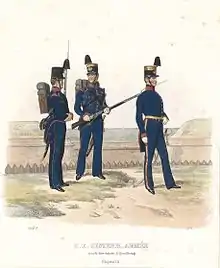Gemeiner (pl. Gemeine, en: private or soldier[1]) was until 1918 the common designation to soldier(s) in the Austro-Hungarian Army (k.u.k. Army) and German Army. In line to the particular branch of service it contained the rank file as follows:
- Dragoner (en: dragoon),
- Grenadier,
- Husar (hussar),
- Infanterist (infantryman)
- Jäger (rifleman),
- Füsilier (fusilier | Am. also fusileer),
- Kanonier (gunner, cannoneer),
- Musketier (musketeer), etc.
- Pionier (engineer)
- Sanitätssoldat (medicalman)
- Trainsoldat (trainman)
- Ulan (uhlan)
| Designation | Austria-Hungary | |||||||||
|---|---|---|---|---|---|---|---|---|---|---|
 |
 |
 | ||||||||
| Rank insignia | ||||||||||
| Rank description | Husar | Infantrist | Jäger | |||||||
| Branch | Cavalry | Infantry | Mountain infantry | |||||||
| (English) | (Hussar only) | (Infantryman) | (Rifleman) | |||||||
- Gallery, "k.u.k. Inf.Rgt. Hoch- und Deutschmeister Nr. 4" (l.t.r)
 Gemeiner and officer
Gemeiner and officer
(1798-1809) Gemeiner and officer
Gemeiner and officer
(1809-1835) Gemeiner and Grenadier
Gemeiner and Grenadier
(1836-1848) Gemeiner and officer
Gemeiner and officer
(1860-1867)
See also
Sources
- BROCKHAUS, The encyclopaedia in 24 volumes (1796–2001), Volume 8: 3-7653-3668-8, page 290; definition: «Gemeiner»
References
- ↑ Langenscheidt's Encyclopaedic Dictionary of the English and German language: „Der Große Muret-Sander“, Part I German-English First Volume A–K, 9th edition 2002, p. 661 – «de: Gemeiner / en: private (common soldier)»
This article is issued from Wikipedia. The text is licensed under Creative Commons - Attribution - Sharealike. Additional terms may apply for the media files.
